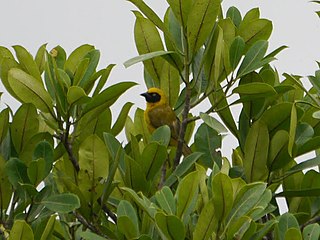
The conservation status of a group of organisms indicates whether the group still exists and how likely the group is to become extinct in the near future. Many factors are taken into account when assessing conservation status: not simply the number of individuals remaining, but the overall increase or decrease in the population over time, breeding success rates, and known threats. Various systems of conservation status exist and are in use at international, multi-country, national and local levels as well as for consumer use.

Notiosorex cockrumi, also called Cockrum's gray shrew or Cockrum's desert shrew, is a tiny species of shrews named in 2003. This red-toothed shrew, which is as light as a penny, is the first new mammal species from Arizona since 1977. Its range extends from Arizona to central Sonora, Mexico.

A species that is extinct in the wild (EW) is one that has been categorized by the International Union for Conservation of Nature as known only by living members kept in captivity or as a naturalized population outside its historic range due to massive habitat loss.

Bannerman's weaver is a species of bird in the weaver family, Ploceidae. It is found in Cameroon and Nigeria. Its natural habitat is subtropical or tropical moist montane forests. It is threatened by habitat loss.

The Somali hedgehog is a species of mammal in the family Erinaceidae. It is endemic to Somalia and Somaliland. The Somali hedgehog is nocturnal.
Siphocampylus affinis is a species of plant in the family Campanulaceae. It is endemic to Ecuador. Its natural habitat is subtropical or tropical moist montane forests. It is threatened by habitat loss.

Siphocampylus is a genus of flowering plants in the family Campanulaceae. There are approximately 221 species native to the Neotropical realm. Most grow in mountain habitat.
Siphocampylus asplundii is a species of plant in the family Campanulaceae. It is endemic to Ecuador. Its natural habitat is subtropical or tropical moist montane forests.
Siphocampylus ecuadoriensis is a species of plant in the family Campanulaceae. It is endemic to Ecuador. Its natural habitats are subtropical or tropical moist montane forests and subtropical or tropical high-altitude grassland. It is threatened by habitat loss.
Siphocampylus fruticosus is a species of plant in the family Campanulaceae. It is endemic to Ecuador. Its natural habitat is subtropical or tropical moist montane forests. It is threatened by habitat loss.
Siphocampylus furax is a species of plant in the family Campanulaceae. It is endemic to Ecuador.
Siphocampylus humboldtianus is a species of plant in the family Campanulaceae. It is endemic to Ecuador. Its natural habitat is subtropical or tropical moist montane forests.
Siphocampylus loxensis is a species of plant in the family Campanulaceae. It is endemic to Ecuador. Its natural habitat is subtropical or tropical moist montane forests. It is threatened by habitat loss.

Siphocampylus lucidus is a species of plant in the family Campanulaceae. It is endemic to Ecuador. Its natural habitats are subtropical or tropical moist montane forests and subtropical or tropical high-altitude grassland. It is threatened by habitat loss.
Siphocampylus rostratus is a species of plant in the family Campanulaceae. It is endemic to Ecuador. Its natural habitat is subtropical or tropical moist montane forests. It is threatened by habitat loss.
Siphocampylus rupestris is a species of plant in the family Campanulaceae. It is endemic to Ecuador. Its natural habitat is subtropical or tropical moist montane forests.

Siphocampylus scandens is a species of plant in the family Campanulaceae. It is endemic to Ecuador and its natural habitat is subtropical or tropical moist montane forests. It is threatened by habitat loss.
Anoura peruana is a species of bat from Colombia and Peru. It was elevated to a species in 2010, after previously being considered a subspecies of Geoffroy's tailless bat. The females are larger than the males.







